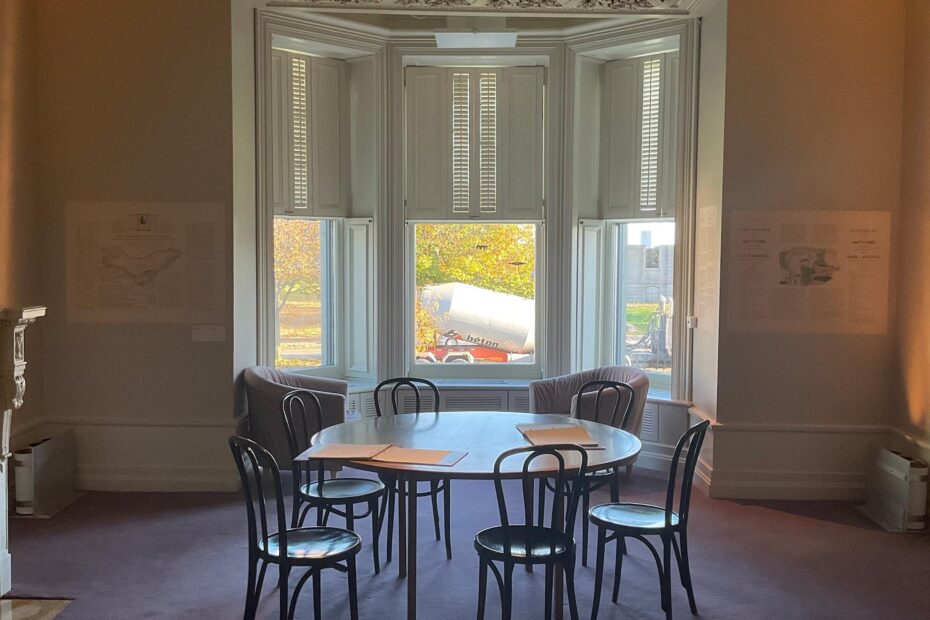On my breaks between classes you can often find me by art museums, procrastinating an assigned reading, and trying to see how many doors are unlocked. Normally, I would not consider yanking door knobs optimal behaviour for a museum visitor, but for experiencing Ange Loft’s Visibly Iroquoian, at The Canadian Center For Architecture (CCA), this skill was definitely a plus . The journey to find all three parts of the installation could be extraordinarily challenging for your average museum visitor. The CCA is a ten minute walk from the Georges-Vanier metro station, and entry is completely free for students. Despite the journey it takes to get there, I would highly recommend going to see this installation – Visibly Iroquoian has completely changed the way I look at the landscape of Montreal by prompting me to look outside of the windows of the CCA and truly see the city around me.
Visibly Iroquoian is an ironic name for such a hidden art piece. Tucked behind the security guard at the entrance of the museum is the first section of the work. If the big burly museum officials don’t scare you away from reading the text on the wall, you will find a truly interesting work of art. Loft asks you to look out the windows and “Consider the Indigenous context in and around the city of Tiohtià;ke/Mooniyang/Montreal.’’ You are prompted to do this through audio recordings telling the stories of Indigenous people around Montreal and purple velvet “whimsies” which are suspended on the windows. The patterns on the whimsies are from Iroquoian pottery discovered on the “Dawson site” in downtown Montreal, which also resemble architectural details seen on the buildings of the CCA. By making this comparison between settler architecture and Iroquoian design Loft wants to create an imaginary “Iroquoian Ancestral Architectural Aesthetic.” If you adjust your position to look out the windows, the whimsies reflect the details of the buildings behind them, or even of the landscape. These interactive elements make the piece very engaging, and the audio accompanying it kept me entertained as I continued to adjust and re-adjust my point of view.
The main exhibitions at the CCA have a simple layout that guides the visitor through the start to the end – but navigating Visibly Iroquoian was not such a simple task. If you manage to look behind the security guard you will find the first part, which explains that the exhibition is made up of two other sections at different windows. And so the hunt begins. The second part is revealed after a short walk down the hall after all the display cases. This area features audio that asks the listener compelling questions and gives them prompts to think on. After you sit there and absorb what is said throughout the 17-minute audio, you can get up and start the journey of finding the final piece of the installation. The only way that I was able to find the last piece was through my rather audacious tendency to just try opening doors whenever I’m exploring a new place.
Behind two sets of heavy doors there is a cold waiting room area adorned with the menacing bust of Thomas George Shaughnessy, quickly followed by another set of doors leading to the old Shaughnessy mansion. I would hope that you chose the set of doors to the left. There you’ll find an open section of the house, and in the far back of the salon there should be a booklet on a table, with maps and text on the wall and whimsies in the window. Here is the final section of Loft’s installation. It speaks directly to the legacy of development in Montreal and the destruction of communities caused by the railway run by The Right Honourable Lord Shaughnessy, whose house this section is located in. Playing on the audio loop is “Carrying Our Bones,” Loft’s interview with Indigenous archeologist, Katsi’tsahèn:te Cross-Delisle, about the archeology and history of their people in Tiohtià;ke.
Having found the final part of the puzzle I sat content, looking out the window as the audio played. It turned out to be very comfy, and I figured it would be a great place to start that reading I had been procrastinating, and maybe take a nap in the little purple chair. Throughout this entire time not a single person came upon me, and no one opened the set of doors to enter the old mansion. At 5:50 p.m. the first sign of life appeared – it was that burly security guard informing me that the museum was closing in ten minutes. Upon my departure I had this sense of pride over finding what few others had, but more than this I was saddened that not many people were seeing Ange Loft’s interesting and insightful work. I would encourage anyone who reads this to go look at Visibly Iroquoian before the installation is closed on September 1, 2024. It’s free for students, and the quiet museum atmosphere is great for a solo visit, hanging with a friend, or even a simple date. Loft’s multi-media work should be enjoyed by more than just trigger-happy door knob grabbers. I invite you to go and explore her work. It might inspire you to go out and truly see Tiohtià;ke.
Addendum: The Canadian Centre for Architecture (CCA) has extended the closing time for the installation until January 9th, 2024.

